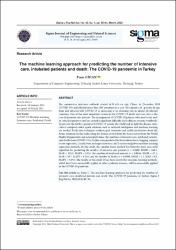| dc.description.abstract | The coronavirus infection outbreak started in Wuhan city, China, in December 2019 (COVID-19) and affected more than 200 countries in a year. The number of patients dying from and infected with COVID-19 is increasing at an alarming rate in almost all affected countries. One of the most important factors in the COVID-19 death and case rates is the care of intensive care patients. The management of COVID-19 patients who need acute and/ or critical respiratory care has created a significant difficulty for healthcare systems worldwide. To prevent the further spread of COVID-19 around the world and to fight the disease, non-clinical computer-aided quick solutions such as artificial intelligence and machine learning are needed. Prediction techniques evaluate past situations and enable predictions about the future situation. In this study, using the dataset created from the data received from the World Health Organization and national database, the numbers of intensive care, intubated patients, and deaths from COVID-19 in flukey were predicted by the random forest, bagging, support vector regression, classification and regression trees, and k-nearest neighbors machine learning regression methods. In this study, the random forest method has been the most successful algorithm for predicting the number of intensive care patients (r = 0.8698, RMSE = 188.5, MAE = 135.1, MAPE = 13%), the number of intubated patients (r = 0.9846, RMSE = 47.1, MAE = 39.7, MAPE = 9.2%), and the number of deaths (r = 0.9994, RMSE = 1.2, MAE = 0.9, MAPE = 3.5%). The results in this study, it has been shown that machine learning methods, which have been successfully applied in other epidemic diseases, will be successfully applied in the COVID-19 pandemic. | en_US |



















